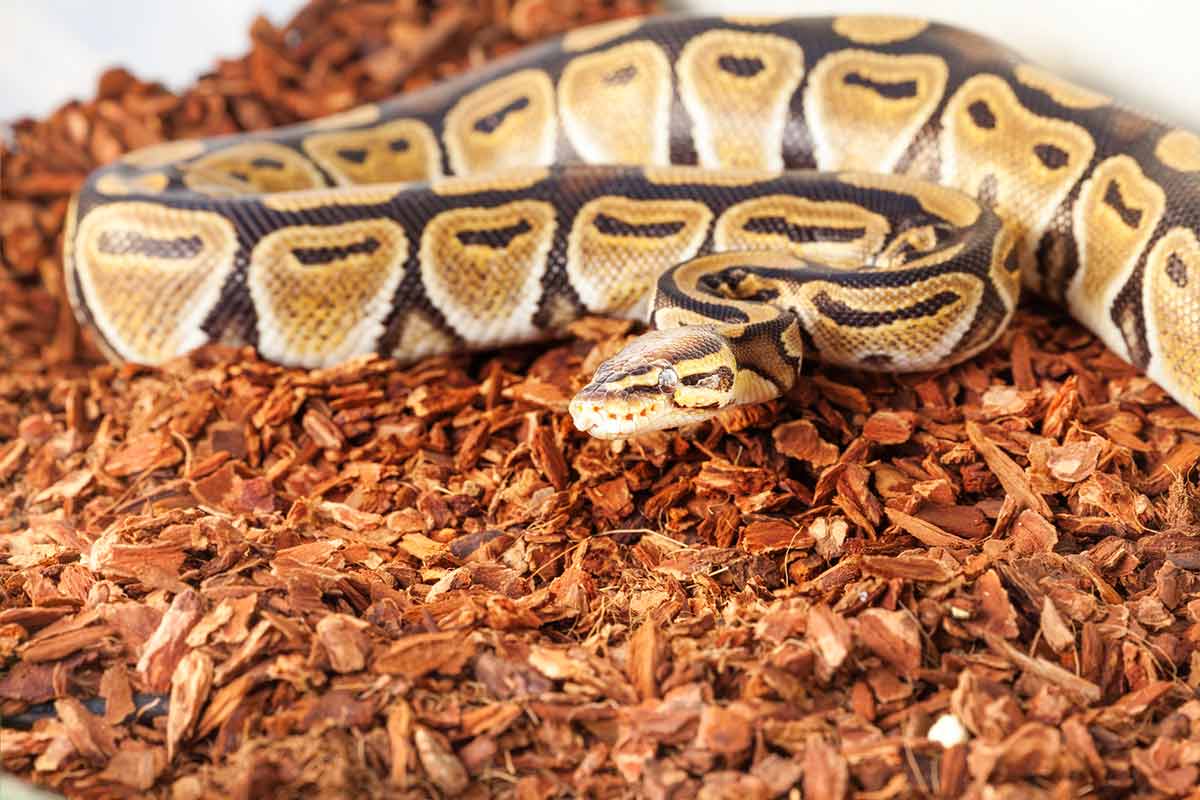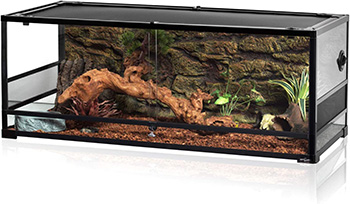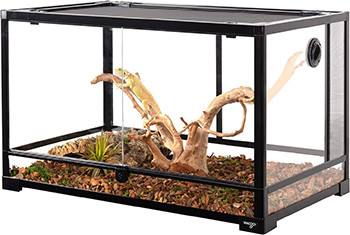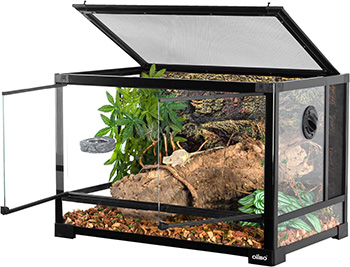Properly caring for a ball python in captivity relies on creating a suitable terrarium habitat for your snake. This starts with finding the best size tank for your python.
Accepted ball python wisdom is that these snakes need “Goldilocks tanks,” which aren’t too big or too small; they should be just right. The perfect size depends on the size of your snake, so you will probably have to change and upscale as your ball python grows.
Today, we’ll explain the size of tank that your ball python is likely to need based on their size, and also talk about their growth rate and at what stages you’re likely to have to upgrade to a larger tank.
But size is only one part of the equation when it comes to creating the ideal habitat. We will also look at some of the essential features your tank needs to be a suitable home for your python, and how to set up your tank in terms of heat, humidity, and features.
Finally, you will find recommendations for a few of the best affordable tanks available for ball pythons.
What Size Tank Is Best For Ball Pythons?
Ask most ball python parents and they will tell you that the ideal size tank for your pet python depends on their size. This is based on the accepted wisdom that young ball pythons can become nervous in tanks that are too large for them. Therefore, you need to start with a small tank for hatchling and juveniles and upgrade as they grow.
But recent studies suggest that it is not necessarily the size of the tank that makes ball pythons nervous. Rather, they can become uncomfortable in large tanks that don’t offer sufficient ground cover in terms of foliage, and that don’t have enough hiding spaces for these nocturnal or crepuscular animals to curl up in during the day.
Therefore, many ball python enthusiasts now believe that you can put smaller snakes in a larger tank, as long as it’s set up properly.
But while there may not be a maximum size that’s too big for your ball python, there certainly is a minimum size that is too small. If their tank is too small and they don’t have enough space to move around, they won’t get the exercise they need. It also means their tank won’t be complex enough to give them the mental stimulation they need to thrive.
So, as a general rule, you need at least 10 gallons of tank per foot of ball python length. So, a 10- to 12-inch-long hatchling can live happily in a 10-gallon tank, but juveniles that reach two feet between the ages of six and nine months need a 20-gallon tank.
As your python reaches two or three years old, they will need a 40-gallon tank to accommodate their size. Full adults, from about the age of four when females can reach as large as six feet, will need a tank that’s between 55 and 75 gallons.
Use the size chart below to understand the size tank that your ball python is likely to need based on their age.
| Age | Size Male | Size Female |
| Hatchling (0-6 months) | 10-17 inches / 50-80 grams | 10-17 inches / 50-80 grams |
| Juvenile (6-9 months) | 20-25 inches / 275-360 grams | 25-30 inches / 300-360 grams |
| One Year | 1.5-2 feet / 500-800 grams | 2 feet / 650-800 grams |
| Two Years | 2-3 feet / 800-1100 grams | 2.5-3 feet / 1200-1800 grams |
| Three Years | 2.5-3.5 feet / 900-1500 grams | 3-5 feet / 1200-2000 grams |
| Four Years + | 3-3.5 feet / 900-1500 grams | 4-6 feet / 2000-3000 grams |
As we’ve already suggested, you don’t necessarily need to invest in a small 10-gallon tank for a hatchling and then upscale when they reach the juvenile stage. Constant upgrading can be expensive since ball pythons grow quickly. You can keep a smaller ball python in a larger tank as long as you fill the tank with hides, branches, and other terrarium elements that help them feel more camouflaged.
You should choose a tank that has a large square footage rather than height, since ball pythons prefer to explore on the ground rather than climb. As a general rule, the longest side of your tank should be at least the length of your ball python. So, your juvenile ball python tank needs not only to be 20 gallons, but also 24 inches in length.
You can keep hatchlings and juveniles together in the same tank, but you need to add five gallons of tank space per additional snake in the space. There should also be enough hides in the tank that they never need to share!
You should not keep adults together in the same tank as they tend to be aggressive toward one another and it can get pretty ugly—even cannibalistic.
Read more about the lifespan and life cycle of ball pythons here.
Tank Requirements
The tank you choose for your ball python not only needs to be the right size, it needs to have the right features and be set up properly for your snake.
As we’ve already said, one of the most important features is a lot of square footage over height so that your ball python has space to move around. A glass tank also tends to be better than tanks made from other materials. Glass is easier to keep clean and hygienic, and tends to be more effective at containing heat and humidity for your snake—and they do like it hot!
You’ll want the ambient daytime temperature of your terrarium to be between 78-80 degrees Fahrenheit. It can drop down as low as 70 at night, but during the day your snake also needs a daytime basking area with a temperature between 88 and 96 degrees Fahrenheit, plus cooler shaded areas.
Humidity in the tank needs to be kept high, at around 50%. It needs to go even higher when they are ready to shed and be raised to 70-80%. This is essential to help them loosen their skin.
It’s also recommended to get a tank that opens from the front rather than the side. While this might be less convenient for you when it comes to accessing your python’s enclosure, it is more comfortable for them. Accessing their tank from above can cause stress as, in the wild, most predators will attack from above.
You need to spot clean your ball python’s tank regularly, and give it a major clean every 30 days. This means removing and disinfecting everything, washing the tank with soap and warm water, disinfecting all tank features, and letting it dry completely before returning everything to its former state.
Best Ball Python Tanks Under $400
You can spend a lot getting the perfect tank for your ball python, but it’s not necessary as there are good options on the market available for between $300-$400.
Repti Zoo 67-Gallon Reptile Terrarium
4.7 stars – 669 Reviews
This 67-gallon tank is ideal for an adult ball python, and once they reach this size, you shouldn’t have to upgrade again. The tank has a good footprint, 48 inches by 18 inches. While this might be too small for the largest females, it will work nicely for most ball pythons.
The tank uses thick, high-hardness tempered glass and opens from the front with a sliding door. The mesh lid and side ventilation insert will support airflow without letting humidity escape. There are also all the essential input points to allow you to wire up your tank for heat and light.
Wacool Tempered Glass 40-Gallon Reptile Tank
4.3 stars – 117 Reviews
This modestly sized tank can work for young ball pythons up to about three or your years old. But once they get much bigger than three feet, they will need something bigger, since the tank’s longest side is just 30 inches.
The tank is made from tempered glass and has a mesh roof and a mesh insert on one side for ventilation. Access is from the front via a lockable sliding door, plus there are six prepared inlet holes for wires and tubing.
OIIBO 70-Gallon Reptile Glass Terrarium
5 stars – 3 Reviews
This large tank should suit larger ball pythons, four feet long and a little longer. It’s made from high-quality, thick tempered glass and has a mesh lid and mesh inserts at the side for ventilation. You can access the tank for cleaning and maintenance via two swing doors at the front as well as the mesh lid.
This tank also has a waterproof bottom, which can be useful when you need to push humidity levels right up for shedding.
Ball Python Tank Size FAQs
Is a 40-gallon tank too big for a ball python?
The ideal size tank for a ball python depends on their size, and they should have about 10 gallons of space per foot of snake. This means that a 40-gallon tank can feel large for a small juvenile, but they can still thrive in the tank as long as it is filled with hides and substrate foliage for them to nest in. This way, you can use the same tank and maybe remove some items as your snake grows.
Do ball pythons prefer long or tall tanks?
Ball pythons prefer to slither on the ground rather than climb, so they prefer long tanks with a big footprint rather than tall tanks. Whenever possible, it’s recommended to get a tank at least as long as your snake. This can be challenging with adult females, which can be as large as six feet long.
Do ball pythons like crowded tanks?
Yes! Ball pythons like to hide so they appreciate places to tuck into and lots of items that act as camouflage. Objects in the tank also provide mental stimulation, and they can feel frustrated in an overly bare tank.
Can two female ball pythons live together?
Unlike many reptile species, it is not recommended to house two female ball pythons together. They are solitary and do not appreciate the company of their own kind. And females are just as likely to get aggressive and attack one another as males.
Do ball pythons need two hides?
Yes, ball pythons do best when they have multiple hides to keep out of sight during the day. A minimum of two hides is recommended, and more if you have space for them.
Housing Your Ball Python
Probably the most important thing to consider when adopting a ball python is creating an appropriate habitat in which they can thrive. Their habitat starts with their tank, which needs to be the right size and have the right features to allow you to maintain heat and humidity levels.
While many people believe that ball pythons don’t like tanks that are too big, you can keep a small ball python in a larger tank as long as it’s filled with plenty of places for them to hide and camouflage and it does not feel barren.
A bigger concern is keeping a ball python in a tank that is too small as they will not get the exercise they need and will lack the mental stimulation they need to thrive.
As a general rule, your ball python needs 10 gallons of tank per foot of their length. The longest side of their tank should also be at least as long as your snake when possible. Of course, this can be challenging with older females, which can grow to as large as six feet long.
Read our guide to how often to feed your ball python.
- Can Guinea Pigs Eat Potatoes? Foods To Avoid - September 24, 2023
- Can Guinea Pigs Eat Carrots? Feeding Advice - September 23, 2023
- How To Make A DIY Bearded Dragon Enclosure - September 22, 2023





Hi, a minimum of 120 gallons is needed for any adult ball python.